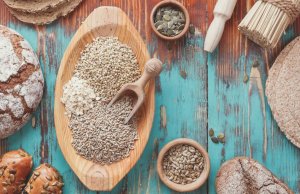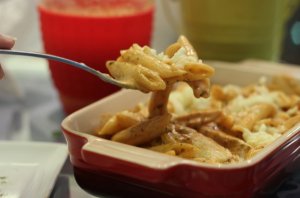Foods With Gluten: all You Need To Know

Gluten is an inherent part of the structure of wheat. More specifically, it makes up most of its proteins. But, it isn’t only found in this cereal, some other foods with gluten include grains such as rye and barley.
The addition of these cereals to other processed products during their preparation means they also contain it. Therefore, it’s necessary to check the labels of these foods if you follow a gluten-free diet.
What is gluten?
Gluten is linked to 80-85 percent of the proteins contained in the cereals mentioned above, and in the case of wheat, it’s composed of gliadins and glutenins.

Functions
- Responsible for the viscous-elastic properties of dough made from wheat, rye and other flours.
- It’s used as a food component to reinforce the quality of some flours.
- Used as a structure-contributing ingredient in other foods.
Gluten consumption
Nowadays, it’s very common for gluten to be present in our diets, as many foods contain it naturally, while others contain it as an ingredient acquired in their manufacturing process.
Contraindications
Not everyone can consume foods containing gluten. This is mainly the case for people who suffer from coeliac disease. Although, we also have to mention sensitivities to non-coeliac gluten and wheat allergies.
The first two conditions have symptoms in common, but a wheat allergy generally has different symptoms. Therefore, the first dietary pattern of coeliac disease and sensitivity to non-coeliac gluten is the elimination of gluten from your diet.
The difference in the case of a wheat allergy is that only wheat and its varieties, or by-products, are eliminated from the diet, and not other cereals containing gluten, although they’re a common element. This is because the cause of the symptoms isn’t gluten, but wheat, unlike the first two conditions.

Foods with gluten
As you can see, you can find gluten naturally in wheat, rye, barley and sometimes in oats, due to agricultural contamination.
However, there are other foods that contain gluten or traces of it. Therefore, it’s important to check the nutritional labels when you’re following a gluten-free diet.
Processed products with gluten
- Some bread, pasta, and biscuits.
- Pre-cooked, dehydrated or frozen vegetables are generally gluten-free but may be at risk of cross-contamination during processing.
- Certain frozen/pre-cooked French fries (pay particular attention to how these are cooked).
- Preserved/canned legumes and bean sprouts may also contain gluten.
- Some frozen, canned and dehydrated fruits.
- Although unlikely, some jellies and marmalades may contain traces of gluten from cross-contamination.
- Fruit juices containing other ingredients (always check the label).
- Pre-cooked meats with sauces and some processed meats such as sausages, hamburgers, black pudding, minced meat and, meatballs. Always check the ingredients.
- Fish substitutes, surimi, and other preparations.
- Powdered milk (sometimes contains added fiber), yogurt with flavoring and margarine.
- Processed cheese. Spreadable cheese, cheese in portions, grated, Roquefort cheese, or cheese with additives.
- Dairy products containing flavorings such as puddings, custards, mousses, and ice-cream).
- Commercial soups, sauces, and stock cubes.
- Chocolate bars with a biscuit base, marshmallows, chocolate creams, icing, and certain other chocolate preparations, always check the label.
- Non-specified beers.
- Colored jelly, dried/processed seaweeds, some candies, and sweets.
As you can see, the list of foods containing gluten within their ingredients is large. This is because flours are added to many industrial products. Therefore, it’s important that you check the nutritional labels of any products you buy.
To conclude, you must be aware of the ingredients in the foods that are part of your daily diet, especially if you suffer from pathologies such as celiac disease or non-celiac sensitivity to gluten.
Gluten is an inherent part of the structure of wheat. More specifically, it makes up most of its proteins. But, it isn’t only found in this cereal, some other foods with gluten include grains such as rye and barley.
The addition of these cereals to other processed products during their preparation means they also contain it. Therefore, it’s necessary to check the labels of these foods if you follow a gluten-free diet.
What is gluten?
Gluten is linked to 80-85 percent of the proteins contained in the cereals mentioned above, and in the case of wheat, it’s composed of gliadins and glutenins.

Functions
- Responsible for the viscous-elastic properties of dough made from wheat, rye and other flours.
- It’s used as a food component to reinforce the quality of some flours.
- Used as a structure-contributing ingredient in other foods.
Gluten consumption
Nowadays, it’s very common for gluten to be present in our diets, as many foods contain it naturally, while others contain it as an ingredient acquired in their manufacturing process.
Contraindications
Not everyone can consume foods containing gluten. This is mainly the case for people who suffer from coeliac disease. Although, we also have to mention sensitivities to non-coeliac gluten and wheat allergies.
The first two conditions have symptoms in common, but a wheat allergy generally has different symptoms. Therefore, the first dietary pattern of coeliac disease and sensitivity to non-coeliac gluten is the elimination of gluten from your diet.
The difference in the case of a wheat allergy is that only wheat and its varieties, or by-products, are eliminated from the diet, and not other cereals containing gluten, although they’re a common element. This is because the cause of the symptoms isn’t gluten, but wheat, unlike the first two conditions.

Foods with gluten
As you can see, you can find gluten naturally in wheat, rye, barley and sometimes in oats, due to agricultural contamination.
However, there are other foods that contain gluten or traces of it. Therefore, it’s important to check the nutritional labels when you’re following a gluten-free diet.
Processed products with gluten
- Some bread, pasta, and biscuits.
- Pre-cooked, dehydrated or frozen vegetables are generally gluten-free but may be at risk of cross-contamination during processing.
- Certain frozen/pre-cooked French fries (pay particular attention to how these are cooked).
- Preserved/canned legumes and bean sprouts may also contain gluten.
- Some frozen, canned and dehydrated fruits.
- Although unlikely, some jellies and marmalades may contain traces of gluten from cross-contamination.
- Fruit juices containing other ingredients (always check the label).
- Pre-cooked meats with sauces and some processed meats such as sausages, hamburgers, black pudding, minced meat and, meatballs. Always check the ingredients.
- Fish substitutes, surimi, and other preparations.
- Powdered milk (sometimes contains added fiber), yogurt with flavoring and margarine.
- Processed cheese. Spreadable cheese, cheese in portions, grated, Roquefort cheese, or cheese with additives.
- Dairy products containing flavorings such as puddings, custards, mousses, and ice-cream).
- Commercial soups, sauces, and stock cubes.
- Chocolate bars with a biscuit base, marshmallows, chocolate creams, icing, and certain other chocolate preparations, always check the label.
- Non-specified beers.
- Colored jelly, dried/processed seaweeds, some candies, and sweets.
As you can see, the list of foods containing gluten within their ingredients is large. This is because flours are added to many industrial products. Therefore, it’s important that you check the nutritional labels of any products you buy.
To conclude, you must be aware of the ingredients in the foods that are part of your daily diet, especially if you suffer from pathologies such as celiac disease or non-celiac sensitivity to gluten.
This text is provided for informational purposes only and does not replace consultation with a professional. If in doubt, consult your specialist.








